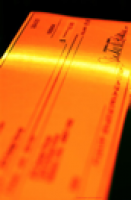Banks and credit unions across the board are increasing deposit limits for mobile remote deposit capture transactions, and with the consumer remote-capture market mostly conquered, financial institutions are turning their attention to small businesses.
Those are two highlights from RemoteDepositCapture.com’s 2017 study of the mobile-capture market. The Alpharetta, Ga.-based publishing and research firm obtained responses last May to July from 195 financial institutions of all sizes for its latest study of the market for depositing checks by having smart-phone users snap pictures of them and upload the images to their bank or credit union through mobile-banking apps.

RemoteDepositCapture.com founder and chief executive John Leekley says the largest deposit-limit category a few years ago was $1,000 to $2,000.
“More financial institutions are becoming more lenient with their deposit limits as they have found that the risks and fears they anticipated really are not materializing,” Leekley tells Digital Transactions News. “We see deposit limits increasing across the board.”
Partly as a risk-control measure, however, banks and credit unions are making funds deposited through mobile capture available somewhat later than they once did. Fifty-one percent have next-day funds availability, compared with 27% for same-day and 7% for immediate availability.
“We do see a trend where funds availability is moving away from immediate and same day to next day,” says Leekley. The business rationale, he says, is that consumers use mobile capture more to avoid a trip to an ATM or bank branch rather than to get immediate access to funds.
One of the biggest fears of early mobile-capture skeptics was the possibility that a single check could be deposited more than once. The study, however, found a duplicate deposit rate among the responding financial institutions of 0.03%, or just three in every 10,000 items deposited.
RemoteDepositCapture.com’s 2015 mobile-capture study found a duplicate rate of 0.0104%, or 1.04 duplicates for every 10,000 items. But Leekley says the two rates aren’t comparable because of the differing base of respondents in each year.
“We’re in the very same ballpark,” he says. “The duplicate loss rate is minuscule, it’s less than five items per 10,000.”
The Federal Reserve Bank of Boston recently reported that 73% of 682 surveyed financial institutions offered mobile capture in 2016. Among RemoteDepositCapture.com’s survey base, 99% offer mobile capture to consumers, 68% to small and mid-sized business (SMBs), and 41% to corporations.
Asked about expansion plans for mobile capture, 41% of respondents said they are aiming for SMBs compared with 23% targeting retail consumers and 22% corporations. Nearly half of respondents, 48%, however, said they weren’t looking at any of those market segments.
Leekley says small businesses want more out of remote-capture than just a convenient deposit. They want reconciliation information and other transaction data. Meeting that demand is spurring new product development from technology vendors and financial institutions.
“For this year, there’s a lot happening on the technology front focusing on the small-business market,” he says. “That’s kind of the new battlefront.”




